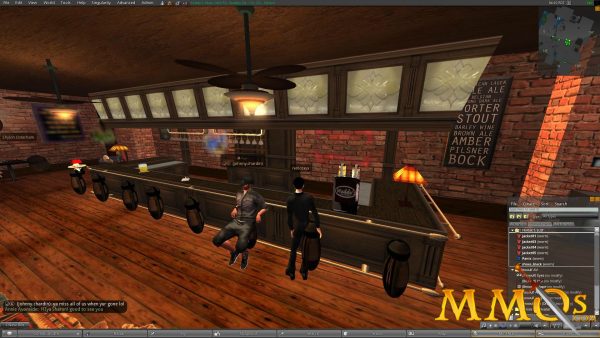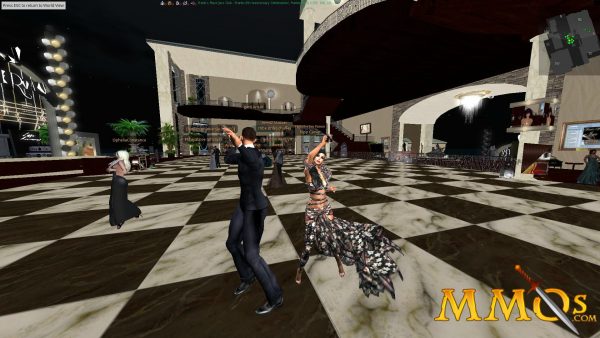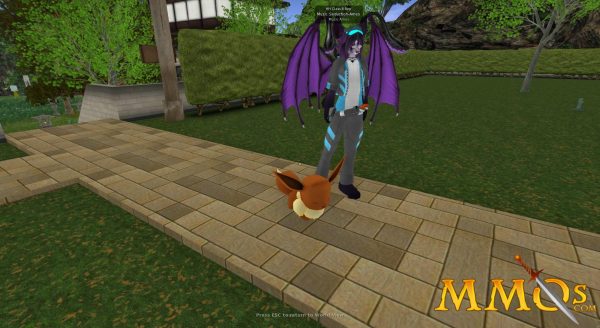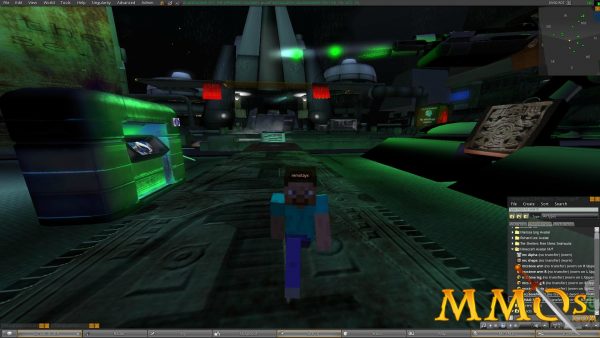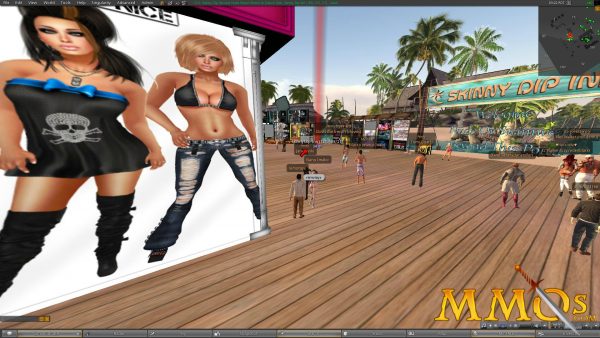Second Life
Second Life is a unique online virtual world where players can socialize, roleplay, and explore in a sandbox environment. Avatars, clothes, animations, houses, and even minigames within Second Life are all created by other players, called residents.
| Publisher: Linden Lab Playerbase: Medium Type: MMO Virtual Universe Release Date: June 23, 2003 Pros: +Player-crafted items. +Near infinite customization options. +Countless unique sims. +Real-world currency exchange. +Great community. Cons: -Steep learning curve. -Cluttered interface. -Slow loading times for textures. |
Second Life Overview
In Second Life, players create and customize their own avatars and are encouraged to explore the nearly limitless virtual world. Second Life isn't a traditional game, as there are no objectives. Instead, players can do whatever they want, but most players typically socialize, roleplay, or explore the countless simulations. Simulations, called sims, are player-created zones, many of which are inspired by popular fictional settings like animes or movies. Second Life is a true sandbox game, as all the content is created by its users. If you can imagine it, you can create it. Everything from animations, vehicles, skin textures, to clothes are designed by players using 3D modeling and scripting software. Player-created content is the name of the game in Second Life and it's not limited to cosmetics. Players can even create objects that others can actually interact with, which gives players room to create interactive minigames.
Second Life Key Features:
- Countless Customization Options – everything about an avatar can be customized, from skin, textures, clothes, body parts, hairstyles, emotes, and more.
- Truly a Sandbox Environment – every aspect of Second Life was created by other users. The virtual world features countless player-made sims and minigames.
- Great Community – the community is vast and varied. There's something for everyone from those looking to roleplay, socialize, or even cyber.
- Real-World Currency Exchange – player-made content can be purchased using Linden Dollars (currency of Second Life). Lindens hold real-world value and can be traded for USDs directly on the game's official website.
- Immersive World – built-in local voice chat and Oculus Rift support creates an immersive environment. Players can also talk through a built-in messenger that supports webcams.
Second Life Screenshots
Second Life Featured Video
Second Life Review
By Miyuki Mitsuhashi
Second Life is an online virtual world developed and published by Linden Lab, and is a game that commands nearly complete dominance over its genre. While there are games out there like Blue Mars and Entropia Universe, none of the competition has been able to quite reach the same level of infamy – cementing itself as a pop culture reference. Second Life originally launched on June 23, 2003 and can be downloaded from their official website for free.
Joining the game as a first time player can be an overwhelming experience. Aside from the relatively easy tutorial, the learning curve is incredibly steep, especially for people that want to fully customize their avatars, which is sort of the whole point of the game. The UI itself can also be quite clunky, as the controls don’t necessarily follow standards set by modern MMORPGs. The default camera view, for example, is located on a tiny bit of UI that pops up on your screen and features two clickable “gamepads.”
The barriers of entry aside, the game does feature an insane amount of customization to suit literally any gaming need. And if you don’t see a system that fits you, you can create it yourself with a bit of scripting knowledge (more on that later).
Second Life isn’t so much a game as it is a virtual world; there are no monsters to slay, levels to gain, or skills to customize. It’s more of a sandbox for socializing, roleplaying, and exploring. This means that it won’t appeal to everyone. Those looking for a more traditional MMO experience should look elsewhere, but those interested in an in-depth social MMO with a large community and excellent customization should read on.
Your First Day in Second Life
Upon first creating your account on Second Life, players are prompted to select a starting avatar. This doesn’t make any lasting impact on the game, as it can be changed later. Immediately upon entering Second Life, you’re forced to do a short tutorial which takes place in a starting zone. The tutorial itself is fairly short, and is mostly composed of movement controls. Despite this, players will have the ability to skip through it, by simply flying through the entire area to reach a gate on the top of the hill.
After that the sky's really the limit, with tons of places to visit known as “sims” that range from replicas of real world cities, zombie survival scenarios, magical fantasy realms with combat systems, and more. Players can even visit the worlds from their favorite animes or even take a stroll through the red light district for a little bit of ‘something else.’ These sims can be accessed through a search, and players can instantly teleport to wherever they choose.
Open Sandbox World
The game itself has no real overarching objective. It's as if someone enhanced the social aspects of an MMORPG like hanging out and socializing, while removing the actual RPG systems in place. There are no real raids (although they could theoretically be created) or objectives, with the gameplay being dictated by what you make of it. There are communities based on region, genre, and even interests. If you’re a big fan of Final Fantasy VII for example, there is a sim for that.
Linden Lab gives players the tools to build exactly what they want in the game for a price, but also allows players to sell their own creations to others. Second Life has a vast marketplace where players can pick up various things from custom-built avatars, vehicles, animations, roleplay tools, weapons and even entertainment systems like televisions that can be watched together in-game.
Without being tied down, you have full freedom to explore the different worlds, create things you want to see in-game, and participate in a way that fits your desires. Second Life is truly a sandbox game. In fact, probably one of the only “actual” sandbox games because players can do practically anything in Second Life. If something doesn’t exist, anyone can just make it. One example of this is the “En Garde” fencing game, which is a short skill-based game within Second Life, where two players fence on a 2D tile grid using a deck of cards. This game didn’t exist until someone programmed it into Second Life and it wasn’t Linden Lab – it was one of the many players within the game.
Huge Marketplace
The game is driven by its economy, both out-of-game and in-game. Players have the option to explore the marketplace on Second Life's official website, using currency known as Linden Dollars. These Lindens can be traded officially for real money on the website (at the time of this post the rate was 250 Lindens per 1 USD). The exchange rate between Lindens and USDs fluctuates based on supply and demand. All trades take place on the LindeX exchange, which matches buyers and sellers. Currency is being bought and sold between players, not the company. Linden Lab profits by taking a small commission on each transaction.
The online marketplace in Second Life is huge and features a vast array of items to enhance the game experience. However, the search function is a bit lacking and it's often hard to find items even if you know the name of them. In several cases, you would type in the exact name of the item and the search would come up with no results.
Alternatively, there are in-game shopping options, which bring a truly immersive feel as you explore malls and try on clothes in-game as if you were doing so in real life. Simply walking around can bring a truly unique experience as you can find and meet other people who are also shopping just like you.
With such freedom comes the price of complexity… as several items would easily confuse a new player. Since all content is created by players and not by Linden Lab themselves, instructions can also be a bit lacking to non-existent.
Nearly Perfect Customization (For a Price)
Since players have the ability to script and create their own content, the character customization in Second Life is by far the most customizable experience in any online game. Players are granted a free avatar at the beginning that can be used to purchase clothing and accessories from various player shops as mentioned before. Players can also purchase completely new avatars and even mesh avatars, becoming anything they want from a cat girl, a wolf, a dragon, or even a tiny faerie. Since everything is made by other players, literally anything is possible.
This is where things can become a bit complicated, as compatibility issues can arise. Certain clothing and accessories are only compatible with certain mesh avatars, leading to quite a confusing mess. However the amount of customization rewarded to those who can brave through the process is second to none, which paves the way for the fervent fashion community that exists. Even a glance online can find several blogs strictly dedicated to the fashion trends within Second Life, and collecting outfits can quickly become a minigame of sorts.
Enjoy Your Second Life
After taking some time to explore and meeting friends, players will find that there are a ton of games within the game of Second Life. Whether you enjoy fencing with others, or simply sitting down for a game of monopoly, there are sims of every type to suit your needs. If you’re a fan of sci-fi, you can find yourself pressing on the dials of a Stargate, or even on the bridge of the Starship Enterprise. If you’re a fan of anime, you might zip through the city of Trost with 3D Maneuver Gear, striking the necks of practice Titans from Attack on Titan. The gameplay is really only limited by your ability to explore.
The game is also incredibly immersive, with the ability to go into first person view and look down to see your own body. Second Life already has built-in Oculus Rift support for virtual reality enthusiasts and a built-in voice chat system that is based on proximity.
There are also Adult Only areas, which are exactly what they sound like… something best left to the imagination and unexplained. But keep in mind, ANYTHING is possible in Second Life.
Final Verdict – Great
Second Life is a game like no other. It offers a truly immersive experience and is perfect for those looking to socialize, roleplay, and explore. Those that can get past the steep learning curve will find a lot to like. Anyone looking for an in-depth virtual world experience needs to give Second Life a try. It’s not for everyone, so if socializing and roleplaying isn’t your thing, look elsewhere.
Second Life Videos
Second Life Links
Second Life Official Site
Second Life Wikipedia
Second Life Official Wiki [Database/Guides]
Second Life Wikia [Database/Guides]
Second Life Subreddit
Second Life Requirements
Minimum Requirements:
Operating System: Windows Vista / 7 / 8 / 10
CPU: Any CPU With SSE2 Support
RAM: 1 GB RAM
Video Card: NVIDIA GeForce 6600 / Radeon 9500 / Intel 945+
Hard Disk Space: 2 GB of free space
Recommended Requirements:
Operating System: Windows Vista / 7 / 8 / 10
CPU: 2 GHz CPU+
RAM: 3 GB RAM
Video Card: NVIDIA GeForce 9000/200 series or ATI 4000 / 5000 series.
Hard Disk Space: 2 GB of free space
Mac OS X Recommended:
Operating System: Mac OS X 10.9+
CPU: 2 GHz Core 2 Duo
RAM: 3 GB RAM
Video Card: Nvidia 9800+ or ATI 4850+
Hard Disk Space: 2 GB of free space
Linux Recommended:
Operating System: Any modern 32-bit Linux environment
CPU: 1.5 GHz+
RAM: 1 GB RAM
Video Card: Nvidia 9800+ or ATI 4850+
Hard Disk Space: 2 GB of free space
Second Life runs best on a fast cable or DSL connection.
Second Life Music
Coming soon!
Second Life Additional Information
Developer(s): Linden Lab
Publisher(s): Linden Lab
Game Engine: Havok
Platforms: Windows, Mac OS X, & Linux
Release Date: June 23, 2003
Development History / Background:
Second Life is developed and published by Linden Lab, a gaming company based in San Fransisco, California. It is built on the Havok game engine. Originally released in 2003, Second Life is the largest virtual world and competes with other social MMOs like Entropia Universe, Blue Mars, OurWorld, and IMVU. Second Life launched with enormous intrigue and quickly penetrated academia and the business world. Institutions like universities and corporations quickly established virtual presences in Second Life to promote their brands. Many of these corporate- and university-sponsored locations still exist within Second Life, but a lot of the intrigue from academia died down over the years. Despite its age, Second Life still remains relevant and has a large community.











